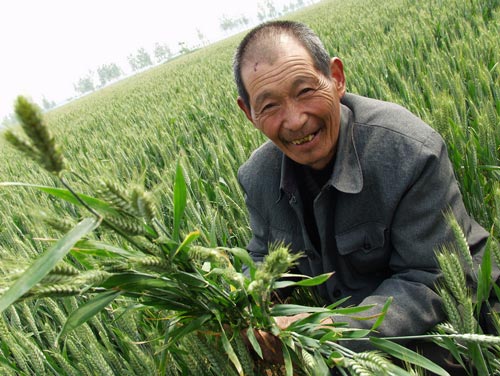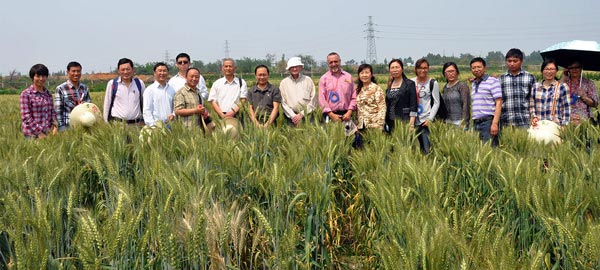 Breeding of durable resistance to stripe rust —the greatest biotic threat to wheat production in the largest wheat producer and consumer in the world, China— was the major theme of a workshop jointly organized by the CIMMYT-Sichuan office and the Sichuan Academy of Agricultural Sciences (SAAS) at the SAAS Plant Breeding Institute in Chengdu, Sichuan province, China, on 18 May 2013. The workshop aimed to promote the adoption of second-generation parents and slow-rusting breeding strategies in spring wheat-producing areas of China and to facilitate collaborative breeding strategies between SAAS and its sister organizations in neighboring provinces. The workshop consisted of a seminar and a discussion session on germplasm and breeding strategies led by Gary Rosewarne (CIMMYT Global Wheat Program senior scientist) and Bob McIntosh (Emeritus Professor at the University of Sydney), and followed by a field visit to the Southern China Field Station at Xindu.
Breeding of durable resistance to stripe rust —the greatest biotic threat to wheat production in the largest wheat producer and consumer in the world, China— was the major theme of a workshop jointly organized by the CIMMYT-Sichuan office and the Sichuan Academy of Agricultural Sciences (SAAS) at the SAAS Plant Breeding Institute in Chengdu, Sichuan province, China, on 18 May 2013. The workshop aimed to promote the adoption of second-generation parents and slow-rusting breeding strategies in spring wheat-producing areas of China and to facilitate collaborative breeding strategies between SAAS and its sister organizations in neighboring provinces. The workshop consisted of a seminar and a discussion session on germplasm and breeding strategies led by Gary Rosewarne (CIMMYT Global Wheat Program senior scientist) and Bob McIntosh (Emeritus Professor at the University of Sydney), and followed by a field visit to the Southern China Field Station at Xindu.
China has the largest area prone to stripe rust epidemics in the world. Traditionally, the disease has been controlled through genetic strategies focused on incorporating major seedling resistance genes to provide immunity. However, this method places strong pressure on the fungus to evolve and overcome these genes. Since the 1950s, the development of virulent pathotypes to widely used resistance genes has caused numerous serious stripe rust epidemics, with the major ones in 1990 and 2002 resulting in the loss of 2.65 and 1 million tons of grain, respectively. Given China’s importance in the world’s wheat production and consumption, any threat to the country’s wheat production has implications for global food security.
CIMMYT has pioneered breeding of durable resistance to stripe rust through the incorporation of multiple, slow-rusting loci, a breeding strategy well established at SAAS but largely ignored by most other wheat breeders in China who still focus on major seedling resistance. At the beginning of this century, SAAS and CIMMYT established a shuttle breeding system to introduce slowrusting loci into Sichuan germplasm. Five high-yielding but susceptible Sichuan lines were sent to Mexico each year for three years; Ravi Singh, CIMMYT distinguished scientist and head of Bread Wheat Improvement, then made single backcrosses with several CIMMYT donor lines. The resulting lines were advanced in Toluca and Obregón, Mexico, and large populations of early generation materials were sent back to Sichuan for further advancement and final selection. Fixed lines from these first generation crosses have shown good levels of resistance in China, along with yields comparable to those of the check varieties. There is currently a range of second generation parental lines with slow-rusting loci in Chinese backgrounds; it is expected that with these as donors, researchers should be able to raise yield potential further while maintaining resistance.
The workshop resulted in a proposed collaborative strategy which would allow breeders representing different regions of China to receive several lines of second generation Chinese slow-rusting donors and to conduct single backcrosses with some of their elite germplasm that has become susceptible. Chinese scientists involved in the process will be invited to help select early generation materials using the bulk selection methodology. After selection, large early generation populations will be sent back to the regions for further selection and advancement under local conditions. “We anticipate that through this mentoring process, breeders will feel comfortable adopting new breeding strategies that can increase their efficiencies and ensure that durable stripe rust resistant lines are released throughout China,” explained Rosewarne.

 Capacity development
Capacity development 
